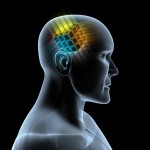Consciousness Is A Verb

It’s not in here.
We live in an individualistic culture and I wonder if that doesn’t bias our understanding of how we behave and think. For instance, we view humans as self-contained and self-sufficient units. There’s a clear boundary between one human and another. Similarly, there’s a clear boundary between each individual and the environment around us. We are separate from each other and from the world.
But what if that’s not the case? What if humans are entangled with each other in much the same way that quantum particles are entangled? Mirror neurons are still somewhat mysterious but what if they allow us to entangle our thoughts with those of other people? Similarly, we’ve learned in the recent past that we think with our bodies as much as our brains. What if our thinking actually extends beyond our bodies and interacts with other thoughts?
Similarly, what if the environment is not separate from us but part of us? What if the environment shapes us much like a river shapes a stone? In a sense, it would mean that we’re not entities but processes. We’re not things but actions. The Buddhists might be right: impermanence is the very essence of our being.
If these things are true, it may give us a key to understanding consciousness. Defining consciousness is known as the “hard problem”. Neuroscientists often phrase the question simply: “What is consciousness?” What if that’s the wrong question? The question implies that consciousness is a thing. It also suggests that consciousness exists somewhere, most likely in the brain. But what if consciousness is not a thing but an action? What if it’s something we do as we interact with the environment? What if we’re swimming in consciousness?
You may have guessed by now that I’ve been reading the works of the philosopher, Alva Noë. (See here and here). Noë studies perception and consciousness and tries to understand how they are entangled. Noë states flatly that, “Consciousness is not something that happens in us. It is something we do.”
Noë goes on to compare consciousness to a dancer, who is influenced by myriad external factors, including the music, the dance floor, and her partner. Dancing is not within the dancer. Noë writes that, “The idea that the dance is a state of us, inside of us, or something that happens in us is crazy. Our ability to dance depends on all kinds of things going on inside of us, but that we are dancing is fundamentally an attunement to the world around us.” Similarly, Noë suggests, consciousness is not within us, rather it is “…a way of being part of a larger process.”
Noë similarly argues that consciousness is not located in a given place. The analogy is life itself. If we look at other people, we can tell that they’re alive. But where is life located in them? We quickly realize that we don’t think of life as a thing that is located in a certain place. Life is not a thing but a dynamic. Noë argues that the same is true of consciousness.
Noë also suggests that cognitive scientists are pursuing the wrong analogy – the computer. This “distinctively nonbiological approach” converts consciousness into a mere computational function that is “…very much divorced from the active life of the animal.” The active life – and engagement with the world around us – creates consciousness in a way that a “brain in a vat” could never do.
What’s it all mean? We’re looking for consciousness in all the wrong places. As Noë concludes, “…the idea that you are your brain or that the brain alone is sufficient for consciousness is really just a mantra, and … there is no reason to believe it.”
What Is Consciousness Good For?

My subconscious is driving the car.
Can you solve a moderately difficult arithmetic problem (say, 3 + 6 – 2 + 5) in your head? Sure, you can. You just need to think about it for a moment.
Could you do the same problem in your head if a researcher were flashing an incredibly annoying bright light in your eye? The light is so bright and flashes so quickly that it’s impossible to focus your attention. Yet, you can still solve the problem. How can that be?
The short answer is that your subconscious (aka System 1 in this website) does the work. It can process arithmetic problems or word puzzles that you’re not consciously aware of.
Professors from the Hebrew University in Jerusalem figured this out with an ingenious experiment. They presented the bright flashing light to one eye and arithmetic or word problems to the other eye. The light was so distracting that subjects didn’t realize that a problem was entering their brain. Yet, they were able to solve it just fine, without realizing that they were doing so. (Here’s the original research article; here’s a less technical summary from the BBC).
The subjects weren’t able to “think about it for a moment”. They couldn’t engage their conscious (System 2) thinking. So, how did they do it? It had to be their subconscious, or System 1.
This finding starts to challenge our long-held beliefs about the differences between our conscious and subconscious processes. We believed that certain skills – like arithmetic and word puzzles – require higher order processing. We need to engage System 2 and focus our attention. But this experiment, and many others like it, demonstrates that System 1 can do a lot more than we expected on its own. (For another example of how your brain can absorb information subconsciously, click here).
Ran Hassin, one of the authors of the flashing light study, went on to create a “Yes It Can” (YIC) model of the subconscious. Hassin asks the simple question, “Which high level cognitive functions can the unconscious perform, and which are uniquely conscious?” After reviewing numerous experiments, he argues, “…that unconscious processes can perform the same fundamental, high-level functions that conscious processes can perform.” (Click here for the article).
Let’s assume for a moment that Hassin is right – our subconscious mind can perform essentially the same functions as our conscious mind. Why, then, do we need consciousness?
Hassin points out that, “Good sprint runners can run 100 meters in less than ten seconds, but more often than not they choose not to.” Similarly, we might be able to use our subconscious for many tasks but – for one reason or another – we choose not to.
When I learned to drive, for instance, I was very conscious of the car itself, the dials on the dashboard, speed, road conditions, and so on. Today, driving is second nature to me. I can drive for miles without being consciously aware of it. It’s often called highway hypnosis.
My subconscious drives the car just fine until something out of the ordinary happens. When something novel (and perhaps dangerous) occurs, I instantly revert to conscious mode. According to Hassin’s argument, my subconscious might be able to handle the novel situation on its own. But, for one reason or another, my conscious mind can handle it better.
Perhaps the main role of consciousness, then, is to practice and master novel skills or to react to novel situations. As our skills improve, our subconscious takes over much of the task. Our conscious mind can move on to new things.
Perhaps our conscious mind continually hungers for novelty. We get bored when there is nothing new for our consciousness to work on. This could even explain the hedonic treadmill. New things engage us and make us happy. Old things fade into the (subconscious) wallpaper.
Consciousness, then, may be a fundamental force driving us toward creativity and innovation. Seen in this light, creativity is not simply a “good thing.” Rather it’s a “necessary thing.” We should pay more attention.
Social Animals and Systems 1 and 2

Your pupils are dilated!
I’ve been reading David Brooks’ book, The Social Animal: The Hidden Sources of Love, Character, and Achievement. The basic idea is fairly simple: we are not alone. How we interact with each other strongly influences who we are and what we become.
Often, however, we don’t recognize just how strong those social forces are. Many of them operate at subconscious levels. Citing Strangers to Ourselves, by Timothy Wilson, Brooks estimates that our minds can take in 11 million pieces of information at any given time. But we’re only aware of 40 of them, at most. Wilson writes that, “Some researchers … suggest that the unconscious mind does virtually all the work and that conscious will may be an illusion.”
Brooks compares the conscious mind to a “… general atop a platform, who sees the world from a distance…” while the unconscious mind is “…like a million little scouts.” The scouts “… maintain no distance from the environment around them, but are immersed in it.”
Brooks also cites Daniel Patrick Moynihan in writing that “… the central evolutionary truth is that the unconscious matters most. The central humanistic truth is that the conscious mind can influence the unconscious.”
If you think that this sounds like System 1 and System 2 that Daniel Kahneman writes about (click here), well… you’re probably right. System 1 is always on, it’s automatic, and it makes quick decisions, often without your realizing it. System 1 is the default setting. Unless System 2 intervenes, System 1 will spin merrily along, running your life. While System 1 is right most of the time, it can make systematic mistakes.
While Brooks’ writing covers similar territory, he approaches from a different angle than Kahneman. He treats not only the influence of the two systems but also the influence of others. How we behave is remarkably influenced by other people.
I expect to write more about Brooks and Kahneman and how they compare. Today, however, I’ll just summarize some interesting tidbits that I’ve picked up from Brooks.
- You can’t consciously control the ends of your eyebrows. When you smile (genuinely) the ends of your eyebrows dip a bit. If you’re faking a smile, they don’t. It’s a clue that’s subconscious to both the sender and receiver – but is usually seen and correctly interpreted.
- You’re sexier when your pupils are dilated. It’s a subtle, subconscious sign of attraction that is usually correctly interpreted even if we aren’t aware of it. (Greek women seemed to understand this and used eye drops to dilate their pupils). As Kahneman points out, dilated pupils also indicate a high level of System 2 activity. So, if you want to look sexy, just do some complex math in your head. Your pupils will dilate and people will think you’re more attractive.
- In general, women are less visually aroused than men. Mena are looking for (visual) fertility clues. Women are looking for evidence of stability.
- Women, on average, are “… 60 to 70 percent more proficient than men at remembering details from a scene and the locations of objects placed in a room.” Simply put, women are more observant.
- People can make judgments about a person’s trustworthiness in a tenth of a second. “These sorts of first glimpses are astonishingly accurate in predicting how people will feel about each other months later.”
- Height is important, at least for men. According to one study, “…each inch of height corresponds to $6,000 of annual salary in contemporary America…” Other people’s height influences our behavior.
I hope these tidbits capture your imagination. They certainly have captured mine and I’ll write a lot more about Brooks and Kahneman in the coming weeks.